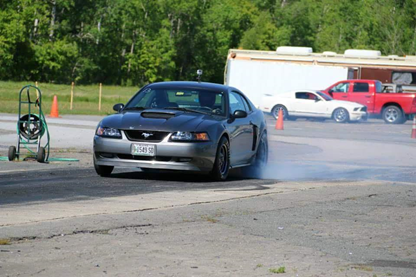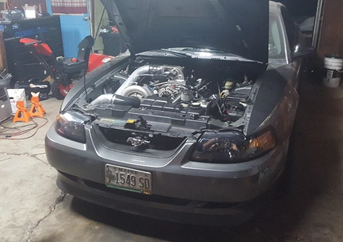
Hello all you Mustang fans and 2V enthusiasts! I am proud to share a quick breakdown and story of my good friend Daryn’s current 665 horsepower, home-built, 4.6 L 2V Mustang! There is a lot to this build and I would like to cover some of the finer details on what makes this a rock solid build compared to others.
Deciding to Rebuild the Engine
Daryn’s Mustang started out, like many relatable projects, relatively stock. Horsepower-by-horsepower it reached the end of the factory rotating assembly’s capabilities, hitting failures around the 400-500 HP mark. He did not stop there, though, doing an entire rebuild complete with an Eagle 4340 crank, Manley rods, and Wiseco pistons, and topped it off with a set of Trick Flow Twisted Wedge heads. Daryn constructed the engine itself in his own personal garage, sourcing his machine work from Bernie Thayer of Thayer’s Automotive in Hermon, ME. The whole project consumed about 1.5 years. The most difficult part of building this fire-breathing 2V was fitting the 8-rib pulley for the Vortech V7 supercharger.

Doing the Math
To make this much horsepower, there’s little internet record to follow for build-aid. Although you can resort to forum-based builds and advice when initially getting into horsepower setups like this, you have to do a lot of the math yourself, and getting it all to fit can take lots of trial and custom work. In Daryn’s case, converting to an 8-rib pulley configuration involved a lot of pulley diameter math to dial in his boost properly. That process proved to the most time-consuming and difficult aspect.
Connecting a T56 Transmission
Now that the power was sorted, it came time to put it all to the wheels. With the factory Tremec transmission replaced by the industry workhorse T56 with 26-spline input shaft and Spec single disk, translating flywheel horsepower to wheel horsepower was getting closer and closer. Fitting T56s to a variety of engines has been common for some time, and the 4.6 L is no different in this case. One U-Joint at the rear pinion and a driveshaft to hold the power made this a breeze. Taking relief from his simplified and more reliable transmission installation, Daryn was ready to hit the dyno.

Tuning to Meet 750 HP
Initial passes were done by Coty Batten of Batten Motorsports in Veazie, ME. The tuning itself was done remotely by Ken Bjonnes of Palm Beach Dyno in Boynton Beach, FL. The remote tuning turned out well. However, running a 3.5 MAF setup and writing over stock software proved to not be fine enough to reach the hp goal of 750. That being said, making a reliable and safe 665hp and 525 foot-pounds on 19PSI of boost, this Mustang’s future looks bright.
We wish the dyno tuning went further. Without the aid of standalone or other tuning types and the need to change a water-methanol injection nozzle, the 750 HP goal still lingers just out of reach, but with a little fine-tuning, it doesn’t seem too far away.

A lot of manpower and parts went into this build to meet Daryn’s HP goals reliably and get the Mustang ready to take track abuse. We will monitor Daryn’s progress closely as his build will ever inch itself towards that HP goal. With not going with a stroker setup as the only regret, we are confident and hopeful he will not stop at 750 HP. Although, when building this, Daryn had considered going alternate directions, the end result hits close to home with any 2V enthusiast. You can be sure Daryn will be out this season making test hits and passes, stretching his 2V’S legs.
Written by Nick Iosua.
Fix Parts on Your Car
Learn to fix parts on your car with 1A Auto’s how-to videos. We have thousands of videos covering repairs and diagnostics to help you replace and fix parts yourself.
More Content with Tips and Advice
- Dome Light Won’t Turn Off When the Door Is Closed?
- How to Clean an Engine Bay
- How to Tuneup a Car: Car Tuneup Checklist
- Common Problems on the 5th Gen Mustang
Shop Parts and Tools

